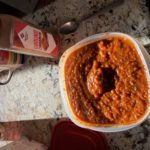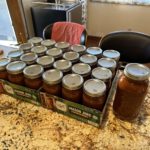 In my quest for the perfect tomato sauce and in furtherance of my goal to never eat commercially produced red junk in a jar, disasters sometimes happen. I ran out of frozen garden tomatoes and my frozen homemade tomato sauce. With a pasta dinner on our minds, I had to improvise. A sauce made from only pantry ingredients? Blasphemy no doubt, but I had no choice. Here’s the invention born out of the womb of necessity.
In my quest for the perfect tomato sauce and in furtherance of my goal to never eat commercially produced red junk in a jar, disasters sometimes happen. I ran out of frozen garden tomatoes and my frozen homemade tomato sauce. With a pasta dinner on our minds, I had to improvise. A sauce made from only pantry ingredients? Blasphemy no doubt, but I had no choice. Here’s the invention born out of the womb of necessity.
2 – tbsp EVOO
1 – 6 oz can tomato paste
4 – 14.5 oz cans diced tomatoes
1 tbsp anchovy paste
1/4 cup dried oregano
1/2 cup dried minced onion
1/4 cup dried basil (we used pesto we’d made last summer)
1 tbsp rubbed sage
1/2 tsp cinnamon
1 tsp black pepper
1 tsp celery powder
2 – tbsp garlic powder (or more)
1 tbsp sea salt (add to taste)
1 tsp sugar
Options: Chile pepper flakes or Louisiana Hot Sauce; a slash of red wine; Fennel seeds for an interesting kick. A shake of cinnamon right before serving can be a real flavor pickup.
All in one pot. Simmer for about 45 min to 1 hour on low heat. Blending with a hand blender is optional depending on texture desired. I like it well blended and smooth. This recipe makes about 10 cups of sauce. Figure about 1 cup of sauce combined with a protein for a good pasta dinner. Not bad for well under $1/cup which is about what store-bought stuff costs. I never add meat/protein or mushrooms into the sauce until I prepare a meal as the sauce is much more flexible for multiple uses without those items.
Disclaimer: This is a recipe that I would use only in an emergency. Normally, I would make enough sauce with garden produce to last for at least an entire year. And obviously, fresh ingredients are preferable to these dried pantry items. Raisins & carrots instead of processed sugar are good. Fresh tomatoes (garden picked are best), celery & onions are best. Dried onions do have a particularly unique taste that I find very desirable in lots of dishes. I sometimes use them instead of fresh onions because of this unique flavor. I still use canned tomato paste sometimes even if I use fresh ingredients for thickening. While seasonal, herbs grown at home are always the best option. This takes good planning and timing. Planting your herbs in spring and making your sauce in the summer months can ensure that the herbs are ready to go when you make sauce. All that said, this recipe is for use when you have to make something off the shelf in a pinch.
While not ideal, one can pull a pretty good sauce out of a well-stocked pantry. Most of these items can be purchased in bulk from one of the big box stores. Stuff like EVOO & anchovies & pasta, I get from a nearby specialty market and keep on hand. We keep all of this stuff in quantities that allow developing recipes without having to worry about going to the store for one or two items. No one at dinner complained about this sauce, (I told no one about the anchovy paste) and unlike store-bought sauce, I can at least pronounce all of the ingredients.
– alla nostra salute
UPDATE:
I made every effort in 2023 to not repeat the errors of last year. Here are two cases of quart jars + one half gallon jar of tomato saue from the 2023 tomato harvest. About 6.5 gallons. I ended up canning just under 10 gallons by end of season. This is about what we use in a year. The sauce is basic and the intention is to further cook/enhance the sauce with other ingredients depending on the recipe it’s being used for. It is a valued, essential, home-made pantry staple and an integral part of my joy of cooking.

